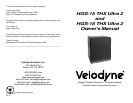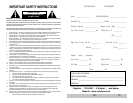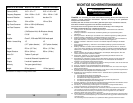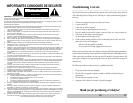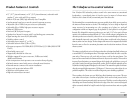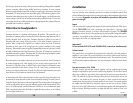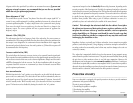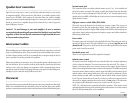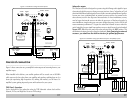
4
☞
A bypass switch is also provided if you wish to use an external crossover. If you are not
using an external crossover, we recommend that you use the one provided
within the unit for optimum performance!
Phase adjustment- 0˚/180˚
This control allows you the "reverse" the phase of the subwoofer's output signal 180˚ to
correct for any possible mismatch & resulting cancellation between the subwoofer and
your main speakers/amplifier. To adjust, simply listen to the system with music playing.
Then move the switch from one position to the other and listen for a change in low
frequency output. The correct position will have a greater amount of apparent low
frequency output.
Subsonic- 15Hz (THX)/35Hz
This adjustment alters the low frequency limit of the subwoofer. For most systems we
recommend the 15Hz setting which will allow the subwoofer to deliver the maximum low
bass output it was designed for. In certain movie theater installations which suggest that
the extreme low bass be limited, move the switch position to 35Hz and the response will
be attenuated below this frequency.
Crossover switch- In/Out (THX)
This switch allows the electronic crossover circuitry to be removed from the signal path.
This is required in certain installations which route the signal through external processors
with a crossover circuit of their own, such as the new digital units. Simply move the switch
to OUT to disengage the built in crossover. For all other installations which do not have
a separate electronic crossover we recommend you leave the internal crossover IN to
provide optimum performance.
Auto turn on function
With this function in the "auto" position, your subwoofer can be safely left with the main
power switch on continuously. The subwoofer will turn itself on automatically when an
audio signal is present. If no signal is present for approximately 15 minutes, the unit will
switch to standby mode. While in standy mode, your subwoofer will draw very minimal
power. This function can be disabled by leaving the switch in the "on" position.
9
response and output level can be drastically influenced by placement, depending on the
acoustic properties of the listening room. Typically, the optimum location for a subwoofer
is tucked away in a corner of your listening room. This location will usually offer the greatest
output levels and optimum low frequency extension. The worst location for a subwoofer
it typically far away from any walls, and close to the center of your room. Avoid these
locations when possible. When using a pair of Velodyne subwoofers in stereo, it is
preferable to place each subwoofer by the satellite of the same channel.
Caution! This subwoofer has electronics built into the cabinet. Do not place
the cabinet next to sources of heat such as furnace registers, radiators, etc. Do
not place the unit near sources of excessive moisture, such as evaporative
coolers, humidifiers, etc. The power cord should be routed in such a way that
it will not be walked on, pinched, or compressed in any way that could result
in damaging the insulation or wire.
Regardless of where you install your Velodyne subwoofer, it must remain in an upright
position (woofer facing forward). Using, shipping, or otherwise storing the subwoofer in
any other position for an extended period of time may result in damage to the unit not
covered by warranty.
The subwoofer is magnetically shielded to reduce the amount of stray magnetic energy
emitted from the speaker's motor structure. This greatly increases flexibility when placing
the unit close to video monitors as there is very little stray magnetism. However, this
shielding may not be adequate in certain extremely sensitive installations. Certain types
of televisions are particularly sensitive to stray magnetic fields. If your television produces
distorted colors after installing your subwoofer, simply increase the distance between your
television and the subwoofer, until normal color and operation is returned.
Protection circuitry
––––––––––––––––––––––––––––––––––––––––––––––––––––––––––––
Your new subwoofer is equipped with special protection circuitry to provide maximum
performance with greatest reliability.
The unit is protected against:
1)Overdriving the speaker or amplifier.
2)Overheating the amplifier.
3)Excessive drop in power line voltage.
☞
continued. . .



